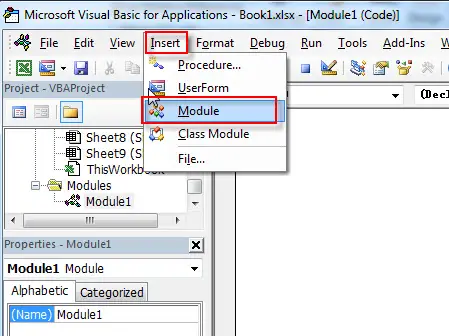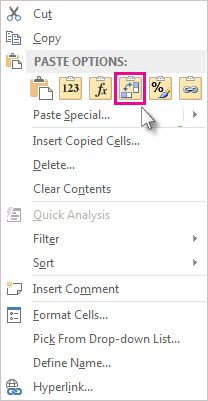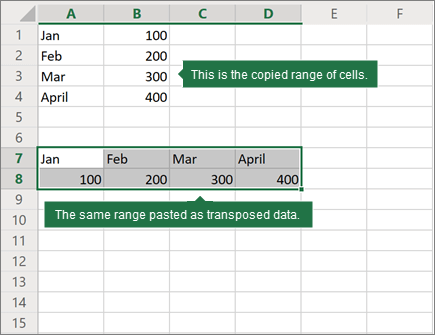This post will guide you how to transpose multiple columns into a single columns with multiple rows in Excel. How do I put data from multiple columns into one column with Excel formula; How to transpose columns into single column with VBA macro in excel.
Assuming that you have a data list in range B1:D4 contain 3 columns and you want to transpose them into a single column F. just following the below two ways.
Table of Contents
- Transpose Multiple Columns into One Column with Formula
- Transpose Multiple Columns into One Column with VBA Macro
- Related Functions
You can use the following excel formula to transpose multiple columns that contain a range of data into a single column F:
#1 type the following formula in the formula box of cell F1, then press enter key.
=INDEX($B$1:$D$4,1+INT((ROW(B1)-1)/COLUMNS($B$1:$D$4)),MOD(ROW(B1)-1+COLUMNS($B$1:$D$4),COLUMNS($B$1:$D4))+1)
#2 select cell F1, then drag the Auto Fill Handler over other cells until all values in range B1:D4 are displayed.
#3 you will see that all the data in range B1:D4 has been transposed into single column F.
Transpose Multiple Columns into One Column with VBA Macro
You can also write an Excel VBA Macro to transpose the data of range in B1:D4 into single column F quickly. Just do the following steps:
#1 click on “Visual Basic” command under DEVELOPER Tab.
#2 then the “Visual Basic Editor” window will appear.
#3 click “Insert” ->”Module” to create a new module.
#4 paste the below VBA code into the code window. Then clicking “Save” button.
Sub transposeColumns()
Dim R1 As Range
Dim R2 As Range
Dim R3 As Range
Dim RowN As Integer
wTitle = "transpose multiple Columns"
Set R1 = Application.Selection
Set R1 = Application.InputBox("please select the Source data of Ranges:", wTitle, R1.Address, Type:=8)
Set R2 = Application.InputBox("Select one destination single Cell or column:", wTitle, Type:=8)
RowN = 0
Application.ScreenUpdating = False
For Each R3 In R1.Rows
R3.Copy
R2.Offset(RowN, 0).PasteSpecial Paste:=xlPasteAll, Transpose:=True
RowN = RowN + R3.Columns.Count
Next
Application.CutCopyMode = False
Application.ScreenUpdating = True
End Sub
#5 back to the current worksheet, then run the above excel macro. Click Run button.
#6 select the source data of ranges, such as: B1:D4
#7 select one single cell in the destination Column, such as: F1
#8 let’s see the last result.
- Excel INDEX function
The Excel INDEX function returns a value from a table based on the index (row number and column number)The INDEX function is a build-in function in Microsoft Excel and it is categorized as a Lookup and Reference Function.The syntax of the INDEX function is as below:= INDEX (array, row_num,[column_num])… - Excel INT function
The Excel INT function returns the integer portion of a given number. And it will rounds a given number down to the nearest integer. And the INT function rounds down, so if you provide a negative number, the returned value will become more negative.The syntax of the INT function is as below:= INT (number)… - Excel ROW function
The Excel ROW function returns the row number of a cell reference.The ROW function is a build-in function in Microsoft Excel and it is categorized as a Lookup and Reference Function.The syntax of the ROW function is as below:= ROW ([reference])…. - Excel Columns function
The Excel COLUMNS function returns the number of columns in an Array or a reference.The syntax of the COLUMNS function is as below:=COLUMNS (array)…. - Excel MOD function
he Excel MOD function returns the remainder of two numbers after division. So you can use the MOD function to get the remainder after a number is divided by a divisor in Excel. The syntax of the MOD function is as below:=MOD (number, divisor)….
Содержание
- Transpose (rotate) data from rows to columns or vice versa
- Tips for transposing your data
- Need more help?
- Transpose Multiple Columns into One Column
- Transpose Multiple Columns into One Column with Formula
- Transpose Multiple Columns into One Column with VBA Macro
- How to convert multi column excel table to single column with header attached
- 2 Answers 2
- Excel: Merge two columns into one column with alternating values
- 4 Answers 4
- So maybe that’s the confusing way to look at it but it’s closer to how my mind works on it. Here is an alternative view:
- Excel — Combine multiple columns into one column
- 5 Answers 5
Transpose (rotate) data from rows to columns or vice versa
If you have a worksheet with data in columns that you need to rotate to rearrange it in rows, use the Transpose feature. With it, you can quickly switch data from columns to rows, or vice versa.
For example, if your data looks like this, with Sales Regions in the column headings and and Quarters along the left side:
The Transpose feature will rearrange the table such that the Quarters are showing in the column headings and the Sales Regions can be seen on the left, like this:
Note: If your data is in an Excel table, the Transpose feature won’t be available. You can convert the table to a range first, or you can use the TRANSPOSE function to rotate the rows and columns.
Here’s how to do it:
Select the range of data you want to rearrange, including any row or column labels, and press Ctrl+C.
Note: Ensure that you copy the data to do this, since using the Cut command or Ctrl+X won’t work.
Choose a new location in the worksheet where you want to paste the transposed table, ensuring that there is plenty of room to paste your data. The new table that you paste there will entirely overwrite any data / formatting that’s already there.
Right-click over the top-left cell of where you want to paste the transposed table, then choose Transpose 
After rotating the data successfully, you can delete the original table and the data in the new table will remain intact.
Tips for transposing your data
If your data includes formulas, Excel automatically updates them to match the new placement. Verify these formulas use absolute references—if they don’t, you can switch between relative, absolute, and mixed references before you rotate the data.
If you want to rotate your data frequently to view it from different angles, consider creating a PivotTable so that you can quickly pivot your data by dragging fields from the Rows area to the Columns area (or vice versa) in the PivotTable Field List.
You can paste data as transposed data within your workbook. Transpose reorients the content of copied cells when pasting. Data in rows is pasted into columns and vice versa.
Here’s how you can transpose cell content:
Copy the cell range.
Select the empty cells where you want to paste the transposed data.
On the Home tab, click the Paste icon, and select Paste Transpose.
Need more help?
You can always ask an expert in the Excel Tech Community or get support in the Answers community.
Источник
Transpose Multiple Columns into One Column
This post will guide you how to transpose multiple columns into a single columns with multiple rows in Excel. How do I put data from multiple columns into one column with Excel formula; How to transpose columns into single column with VBA macro in excel.
Assuming that you have a data list in range B1:D4 contain 3 columns and you want to transpose them into a single column F. just following the below two ways.
Transpose Multiple Columns into One Column with Formula
You can use the following excel formula to transpose multiple columns that contain a range of data into a single column F:
#1 type the following formula in the formula box of cell F1, then press enter key.
#2 select cell F1, then drag the Auto Fill Handler over other cells until all values in range B1:D4 are displayed.
#3 you will see that all the data in range B1:D4 has been transposed into single column F.
Transpose Multiple Columns into One Column with VBA Macro
You can also write an Excel VBA Macro to transpose the data of range in B1:D4 into single column F quickly. Just do the following steps:
#1 click on “Visual Basic” command under DEVELOPER Tab.
#2 then the “Visual Basic Editor” window will appear.
#3 click “Insert” ->”Module” to create a new module.
#4 paste the below VBA code into the code window. Then clicking “Save” button.
#5 back to the current worksheet, then run the above excel macro. Click Run button.
#6 select the source data of ranges, such as: B1:D4
#7 select one single cell in the destination Column, such as: F1
#8 let’s see the last result.
Источник
How to convert multi column excel table to single column with header attached
Hi can anyone let me know if there is a good way to convert table 1 to table 2 in excel? this is just a example the actual data is in thousands of rows.
2 Answers 2
If you have Excel O365, you could opt for:
You can use Power Query, available in Excel 2010+
It is a part of Excel 2016+ and available as a free Microsoft provided add-in in the earlier versions.
- Data / Get & Transform / From Table/Range
- If A , B and C are not the Headers then (In the Power Query UI)
- Home / Transform / Use First Row as Headers
- Select all the columns and
- Transform / Any Column / Unpivot Columns
- Sort by Attribute and Value , in that order
- Move the Value column to the first column position
- Home / Close / Close & Load
All of the above steps can be done from the Power Query UI, but here is the generated M-Code
Источник
Excel: Merge two columns into one column with alternating values
how can I merge two columns of data into one like the following:
4 Answers 4
You can use the following formula in column D as per my example. Keep in mind to increase the $A$1:$B$6 range according to your data.
Thank you to @Koby Douek for the answer. Just an addition—if you are using Open Office Calc, you replace the commas with semi-colons.
Expanding @koby Douek’s answer to more columns and explaining some of the terms
Original Code for 2 columns to 1 alternating =INDEX($A$1:$B$6,INT((ROWS(D$2:D2)-1)/2)+1,MOD(ROWS(D$2:D2)-1,2)+1)
$A$1:$B$6 Defines the columns and rows to source the final set of data from, the $s are only present to keep the formula from changing the columns and rows selects if it is copied and pasted or dragged.
To extend to work on any values you dump into the columns instead of having to expand the range every time it should be amended to $A:$B or A:B so you can easily copy it to other sets of columns and create new merges, but it will also give the 1st value in every column as one of the alternating values so if you instead have headers you would be able to do this by instead using a large number so $A$1:$B$99999 or A$1:B$99999 if you want to past and move the columns ymmv which is better by situation.
lets assume you are fine including the values in the 1st row
This changes the formula to =INDEX($A:$B,INT((ROWS(D$2:D2)-1)/2)+1,MOD(ROWS(D$2:D2)-1,2)+1)
This is the row that is being used to calculate the difference between the current row the formula is in ( D2 ) and the reference row ( D$2 ) The important thing to make sure you do is to set the reference row number to the 1st row you will be putting values in, so if your 1st row is a header in the sort column you will use the 2nd row as the reference, if your values in the combined column D begin on the 3rd row then the reference row would be D$3
Since I like the more general form where the 1st row isn’t a header row I’ll use D$1:D1 but you could still mix source rows without headers into a combined row with a header of as many rows as you like just by incrementing that reference row number to be the 1st row where your values should begin.
This changes the formula to =INDEX($A:$B,INT((ROWS(D$1:D1)-1)/2)+1,MOD(ROWS(D$1:D1)-1,2)+1)
Now INT((ROWS(D$1:D1)-1)/2)+1 and MOD(ROWS(D$1:D1)-1,2)+1
INT returns an integer value so any decimal places are dropped, it essentially functions like rounding down to the nearest whole number
MOD functions by returning the remainder of a division, it’s result will be a whole number between 0 and n-1 where n is the number we are dividing by. (eg: 0/3=0; 1/3=1; 2/3=2; 3/3=0; 4/3=1 . etc)
the first value is again the difference between the current row and the reference row. but D$1:D1 is going to be the count of the rows, which is 1 so we have to correct for the rows count starting at 1 instead of 0 which would throw off our calculations, so both are using the -1 to reduce the count of the rows by 1
in the case of /2 and ,2 both are because we are dividing by 2 in the first statement it’s a normal division by 2 /2 in the modulus statement it’s an argument of the Mod function so ,2
finally we need to add 1 using +1 to correct for the index’s need to have a value series which begins at 1.
INT((ROWS(D$2:D2)-1)/2)+1 is finding the row number to select the value from.
MOD(ROWS(D$1:D1)-1,2)+1 is finding the column number to select the value from
Thus we can change /2 and ,2 to /3 and ,3 to do this with 3 columns
This yields: =INDEX($A:$B,INT((ROWS(D$1:D1)-1)/3)+1,MOD(ROWS(D$1:D1)-1,3)+1)
So maybe that’s the confusing way to look at it but it’s closer to how my mind works on it. Here is an alternative view:
=INDEX([RANGE],[ROW_#],[COLUMN_#]) returns the value from a range of rows and columns
Using the example: =INDEX($A:$B,INT((ROWS(D$1:D1)-1)/3)+1,MOD(ROWS(D$1:D1)-1,3)+1)
[RANGE] = $A:$B this is the range of source columns.
INT([VALUE_A])+1 returns an integer value so any decimal places are dropped. Then adds one to it. we add one to the value because the result of the next steps will be 1 less than the value we need.
[Value_A] = (ROWS(D$1:D1)-1)/3 ROWS(D$1:D1) returns the number of rows in the Range to the current row in the results column, we use D$1 to designate the row number where the values in the results column begin. D1 is the current row in the results column giving us a range from the source row, allowing us to count the rows. we have to subtract 1 from this value using -1 to get the difference between the source and current. This is then divided by /3 because we have three columns we want to look through in this example so we only change rows when the result is divisible by 3. the INT drops any decimal places as mentioned so it only increments when cleanly divisible by 3.
MOD([VALUE],[Divisor])+1 returns the remainder of the value when divided by the divisor.
Using the example: MOD(ROWS(D$1:D1)-1,3)+1
In this case we still divide by 3 but it’s an argument to the MOD function, we still need to count the number of rows and subtract 1 before dividing it, this will return a 0, 1, or 2 for the column, but as above we are shifted backwards by 1 as the column numbers begin with the number 1, so as before we must add 1
Источник
Excel — Combine multiple columns into one column
I have multiple lists that are in separate columns in excel. What I need to do is combine these columns of data into one big column. I do not care if there are duplicate entries, however I want it to skip row 1 of each column.
Also what about if ROW1 has headers from January to December, and the length of the columns are different and needs to be combine into one big column?
should combine into
The first row of each column needs to be skipped.
5 Answers 5
Try this. Click anywhere in your range of data and then use this macro:
You can combine the columns without using macros. Type the following function in the formula bar:
The statement uses 3 IF functions, because it needs to combine 3 columns:
- For column A, the function compares the row number of a cell with the total number of cells in A column that are not empty. If the result is true, the function returns the value of the cell from column A that is at row(). If the result is false, the function moves on to the next IF statement.
- For column B, the function compares the row number of a cell with the total number of cells in A:B range that are not empty. If the result is true, the function returns the value of the first cell that is not empty in column B. If false, the function moves on to the next IF statement.
- For column C, the function compares the row number of a cell with the total number of cells in A:C range that are not empty. If the result is true, the function returns a blank cell and doesn’t do any more calculation. If false, the function returns the value of the first cell that is not empty in column C.
Источник
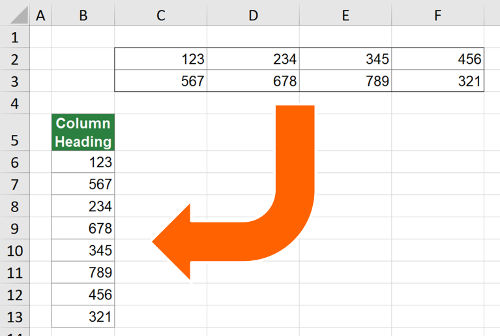
Say, you have an Excel table and want to copy all column underneath each other so that you only have one column. For example, you have a table 2 rows by 4 columns like in the screenshot on the right-hand side. You want to copy and paste this table to one column. You often need such transformation for inserting PivotTables or to create database formats. This article provides 4 simple methods to transform a 2-dimensional table into one column in Excel.
Example

The following methods will be introduced with a simplified example as shown on the right-hand side. You have a table with numbers within the cell range A1 to G7. That means you have 7 rows and also 7 columns. In total 49 cells to be copied to one column.
Method 1: Copy table to one column manually
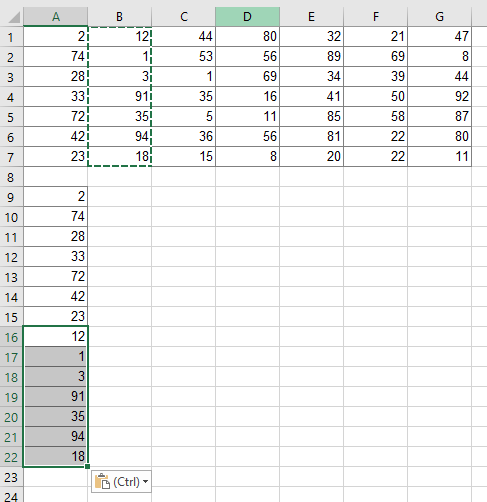
Like so often, copying and pasting the columns manually might be the fastest solution. Given that you are reading this article, this might not be the method you want to hear. But anyway, doing it manually is often the fastest way.
Maybe some advice to speed up the manual process might help. Try to use as many keyboard shortcuts as possible. That way you could save some time.
- Holding Ctrl and pressing one of the arrow keys makes you jump between tables and cells.
- Holding the Shift key, you can select cells and ranges.
- And – of course – with Ctrl + C and Ctrl + V you can copy and paste cells.
For more information about the keyboard shortcuts please refer to our big keyboard shortcut package.
Method 2: The INDEX formula
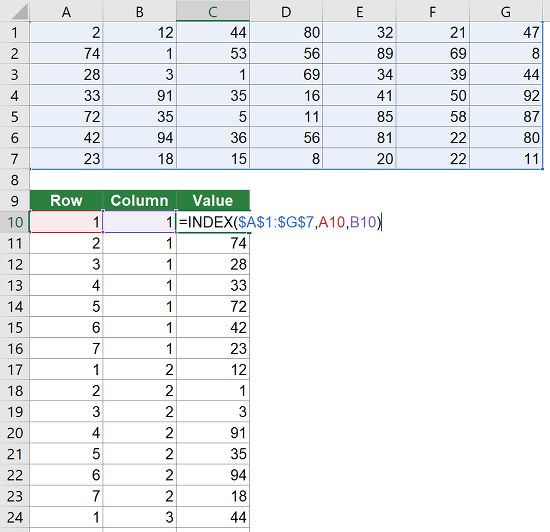
You can convert a two-dimensional table into just one column by using the INDEX formula. Unfortunately, it requires some preparations. But on the other hand, it’s one of the faster ways (compared to setting up the more complex OFFSET formula like in method 3 below or the INDIRECT formula).
Let’s see what you need to prepare. Basically you have to create the column and row number in additional helper columns. That way you can easily refer to the original table. The screenshot on the right-hand side shows the necessary preparations.
- You need one column containing the row number (here in column A). You always start with 1. So if you data start in row 3, the first number you write is still 1.
- You need one column containing the column number (here in column B). Also for the column number you always start with number one.
- The third column contains the actual values, pulled by the formula =INDEX($A$1:$G$7;A10;B10) . Example: In cell C10, the INDEX formula returns the value from the first row and first column of the range A1 to G7.
Please refer to this article for more information about the INDEX formula in Excel.
Method 3: OFFSET formula
The third method uses the OFFSET formula for copying several columns underneath each other to one column. If you need some introduction to the OFFSET formula, please refer to this article.
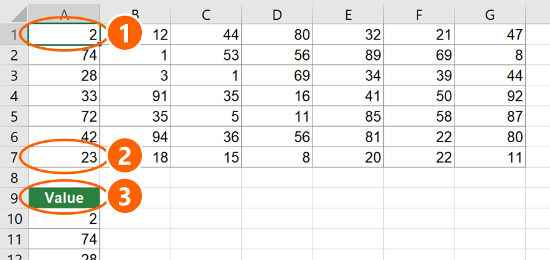
Because the formula is – in this universal case – very long, we don’t go much into detail here. It’s based on three cells.
- The top left cell of the table you want to convert (here: A1).
- The bottom left cell of the table you want to convert (here: A7).
- The heading cell of your single column, which is supposed to contain all the data from the table (here: A9)
Now you just have to replace the cell links in the following formula with your cells. Don’t forget to fix the references with the $-signs as shown in the formula below.
=OFFSET($A$1,(ROW()-ROW($A$9)-1)-(ROW($A$7)-ROW($A$1)+1)*ROUNDDOWN((ROW()-ROW($A$9)-1)/(ROW($A$7)-ROW($A$1)+1),0),ROUNDDOWN((ROW()-ROW($A$9)-1)/(ROW($A$7)-ROW($A$1)+1),0))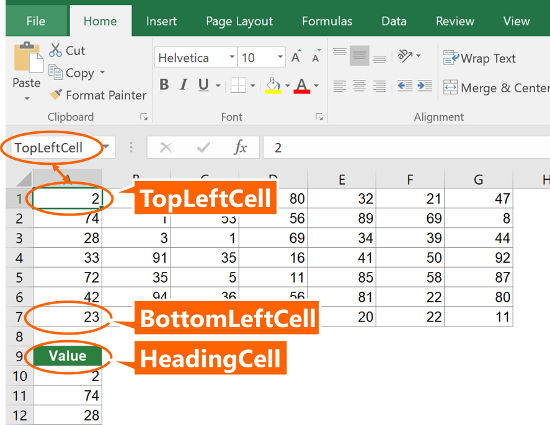
In order to make it easier for you to use the formula, you can use the version below. All you have to do is to give names to the three main cell as shown in the image on the right-hand side. In order to achieve this, select the top left cell of your original table (here: A1) and click into the name field. Type “TopLeftCell” and press Enter on the keyboard. Repeat this with the bottom left cell (name “BottomLeftCell”) as well as the heading cell of your new table (name “HeadingCell”).
Once done, copy and paste the following formula it the first cell (here: A10). Now just copy and paste this cell down until all columns from your original table are covered.
=OFFSET(TopLeftCell,(ROW()-ROW(HeadingCell)-1)-(ROW(BottomLeftCell)-ROW(TopLeftCell)+1)*ROUNDDOWN((ROW()-ROW(HeadingCell)-1)/(ROW(BottomLeftCell)-ROW(TopLeftCell)+1),0),ROUNDDOWN((ROW()-ROW(HeadingCell)-1)/(ROW(BottomLeftCell)-ROW(TopLeftCell)+1),0))Method 4: Professor Excel Tools
You want to use the most convenient way? Try the Excel add-in “Professor Excel Tools”. The steps are shown in the screenshot below.
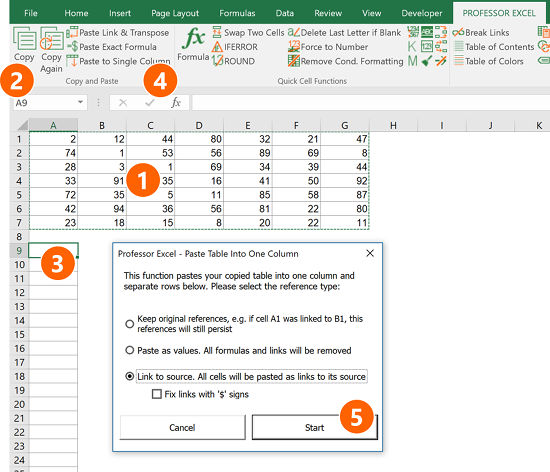
- Select the table you want to transform into a single column.
- Click on Copy on the left-hand side of the “Professor Excel”-ribbon.
- Select the first cell from which Professor Excel should paste the columns underneath.
- Click on “Paste to Single Column” on the “Professor Excel” ribbon.
- Now you can finetune the copy-and-paste-format. Do you which to copy the formulas without changing cell references, do you which to copy them as values or do you want to insert links to the original table? Then press Start.
That’s it. Do you want to try “Professor Excel” for free? Then just follow this link for more information or start the download right away.

This function is included in our Excel Add-In ‘Professor Excel Tools’
(No sign-up, download starts directly)
Download
Please feel free to download all examples shown above in one comprehensive Excel file. Just click on this link and the download starts right away.
Are you having difficulty merging two or more Excel columns? Knowing how to combine multiple columns in Excel without losing data is a handy time-saver that allows you to consolidate your data and make your sheet look neater.
First and foremost, you should know that there are multiple ways you can merge data from two or more columns in Excel. Before we get started exploring these different ways, let’s start with a key step that helps the process — how to merge cells in Excel.
If you want to combine Google Sheets data, you can do that easily using Layer. Layer is a free add-on that allows you to share sheets or ranges of your main spreadsheet with different people. On top of that, you get to monitor and approve edits and changes made to the shared files before they’re merged back into your master file, giving you more control over your data.
Install the Layer Google Sheets Add-On today and Get Free Access to all the paid features, so you can start managing, automating, and scaling your processes on top of Google Sheets!
How to Combine Multiple Cells or Columns in Excel Without Losing Data?
Once you have merging cells under your belt, learning how to combine multiple Excel columns into one column becomes intuitive.
Whether you’re learning how to combine two cells in Excel, or ten, one of the main benefits of merging is that the formulae don’t change. Here are the following ways you can combine cells or merge columns within your Excel:
Use Ampersand (&) to merge two cells in Excel
If you want to know how to merge two cells in Excel, here’s the quickest and easiest way of doing so without losing any of your data.
- 1. Double-click the cell in which you want to put the combined data and type =
- 2. Click a cell you want to combine, type &, and click the other cell you wish to combine. If you want to include more cells, type &, and click on another cell you wish to merge, etc.
- 3. Press Enter when you have selected all the cells you want to combine

While this is useful for quickly merging data into a single cell, the merged data will not be formatted. This can make data untidy or challenging to read in some instances (e.g. full names or addresses).
If you want to add punctuation or spaces (delimiters), follow the below steps. For this example, let’s put a comma and a space between the first and last name as you would see on a registration list:
- 1. Double-click the cell in which you want to put the merged data and type =
- 2. Click a cell you want to merge
- 3. This time, type &”, ”& before you click the next cell you want to merge. If you want to include more cells, type &”, ”& before clicking the next cell you want to merge, etc.
- 4. Press Enter when you have selected all the cells you want to combine

As you can see, now your merged data comes out in a neater format, with each piece of data appropriately separated.
Use the CONCATENATE function to merge multiple columns in Excel
This method is similar to the ampersand method, and also allows you to format your merged data. First, you need to use the CONCATENATE function to merge a row of cells:
- 1. Insert the =CONCATENATE function as laid out in the instructions above
- 2. Type in the references of the cells you want to combine, separating each reference with ,», «, (e.g. B2,», «,C2,», «,D2). This will create spaces between each value.
- 3. Press Enter

Now that you have successfully merged your cells, you can follow these simple steps to merge multiple columns:
- 1. Hover your mouse over the bottom-right corner of the merged cell you just created
- 2. When the cursor changes into a + symbol, drag your cursor as far down the column as you want and release it

Once you release the mouse, you should see that your merged cell has become a merged column, containing all of the data from your chosen columns.
*The CONCAT function is another formula used for combining data from different cells. However, it is limited to two references and does not allow you to include delimiters.
Use the TEXTJOIN function to merge multiple columns in Excel
This method works only with Excel 365, 2021, and 2019. As you can probably tell, this function is helpful when you want to combine two or more text cells in Excel.
The following steps will show you how to use the TEXTJOIN function, once again using the comma and space combination to create your first merged cell:
- 1. Double-click the cell in which you want to put the combined data
- 2. Type =TEXTJOIN to insert the function
- 3. Type “, ”,TRUE, followed by the references of the cells you want to combine, separating each reference with a comma (the role of TRUE is to disregard empty cells you may have input)
- 4. Press Enter

In order to create the rest of your combined column, use the drag-and-drop steps listed below:
- 1. Hover your mouse over the bottom-right corner of the merged cell you just created
- 2. When the cursor changes into a + symbol, drag your cursor as far down the column as you want and release it.

Now your columns of data have successfully merged into your new column.
The Beginner’s Guide to Excel Version Control
Discover what Excel version control is, the version control features Excel has to offer, and how to use them to share, merge, and review Excel changes
READ MORE

Use the INDEX formula to stack multiple columns into one column in Excel
Let’s say you want to create a stack of data from your multiple columns, rather than create a single cell. You can easily do this across multiple cells and columns within your spreadsheet using the INDEX formula:
- 1. Select all of the cells containing your data
- 2. Type in a name for this group of data in the “Name Box” (box located to the left side of the formula bar). In this example, I’ve named the data “_my_data”
- 3. Select an empty cell in your Excel sheet where you want your stacked data to be located. Input the following INDEX formula (remember to substitute with your data name):
=INDEX(_my_data,1+INT((ROW(A1)-1)/COLUMNS(_my_data)),MOD(ROW(A1)-1+COLUMNS(_my_data),COLUMNS(_my_data))+1)
-
4. The first value from your data range should appear. Hover over the cell until the cursor changes into a + symbol, and drag your cursor as far down until you receive a #REF! value (this signals the end of your data set)
Other ways to combine multiple columns in Excel: Notepad and VBA script
There are two other ways you can combine multiple columns in Excel. These are often more time-consuming, and use other tools as part of the process. However, they may be more helpful for users who wish to avoid using Excel formulae.
Use Notepad to merge multiple columns in Excel
You can use Notepad to extract, format, and replace your data from multiple columns in your Excel. For this, you need to copy and paste each column from your Excel sheet into a Notepad file. Then, use the Replace function to add commas between each value. Once finished, you can copy and paste your formatted data back into your Excel.
Use VBA script to combine two or more columns in Excel
As an alternative to the INDEX function stacking method, you can use VBA script. Simply right-click and select “View code” within your Excel, and copy and paste the code in a new window. Press “F5” to run the code and create a Macro. You can then apply this to your Excel by selecting your data range and applying it to your destination column.
Want to Boost Your Team’s Productivity and Efficiency?
Transform the way your team collaborates with Confluence, a remote-friendly workspace designed to bring knowledge and collaboration together. Say goodbye to scattered information and disjointed communication, and embrace a platform that empowers your team to accomplish more, together.
Key Features and Benefits:
- Centralized Knowledge: Access your team’s collective wisdom with ease.
- Collaborative Workspace: Foster engagement with flexible project tools.
- Seamless Communication: Connect your entire organization effortlessly.
- Preserve Ideas: Capture insights without losing them in chats or notifications.
- Comprehensive Platform: Manage all content in one organized location.
- Open Teamwork: Empower employees to contribute, share, and grow.
- Superior Integrations: Sync with tools like Slack, Jira, Trello, and more.
Limited-Time Offer: Sign up for Confluence today and claim your forever-free plan, revolutionizing your team’s collaboration experience.
Conclusion
As you can see, combining multiple columns is easy in Excel. Whether you’re combing multiple Excel files, or columns and cells, there are a variety of ways that cater to different users, depending on their technical abilities or needs.
As a result, not only can you format your Excel into a cohesive and seamless spreadsheet, but also save time and optimize your productivity when evaluating, managing, or sharing important data. Once you know how to combine multiple columns in Excel into one column, combining or merging your data can become one quick and simple task.
If all of the Rows have the same number of columns, then you can use INDEX, INT, COUNTA and MOD to break this down.
Column A:
=INDEX(Sheet1!$A$1:$D$2,1+INT((ROW()-1)/(COUNTA(Sheet1!$1:$1)-1)),1)
Column B:
=INDEX(Sheet1!$A$1:$D$2,1+INT((ROW()-1)/(COUNTA(Sheet1!$1:$1)-1)),2+MOD(ROW()-1,COUNTA(Sheet1!$1:$1)-1))
Where Sheet1!$A$1:$D$2 is the ‘Input’ range, and Sheet1!$1:$1 is any row in that range with a full row of data.
INDEX lets you get a specific row/column of a range. Our Range is Sheet1!$A$1:$D$2, and the Row is the same for both formulae:
1+INT((ROW()-1)/(COUNTA(Sheet1!$1:$1)-1)),
This will be 1 for n rows, 2 for the next n, etc, where n is the number of cells in a row minus the starter column (i.e. how many names per gender)
(INT removes the decimal part of a number, so INT(3/4) is INT(0.75), which is 0. COUNTA just counts the non-blank cells)
The difference between the two is the Column. In column A, we just want the first column, so Column is 1. In column B, we want the xth item after the first column, where x A) counts up by 1 each row and B) resets to 1 when we go from Male to Female (or beyond)
Now, the MOD function lets us do that fairly simply: MOD(0, 3) is 0, MOD(1, 3) is 1, MOD(2, 3) is 2, and MOD(3, 3) is back to 0. We just need to start out row count at 0 (subtract 1 from Row, and add it back outside the MOD) and remove the first column from the items-per-row (subtract 1 from the COUNTA, add 1 outside the MOD)


